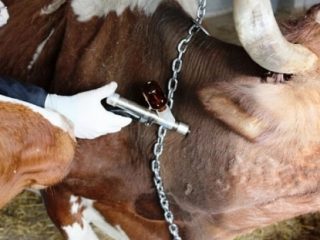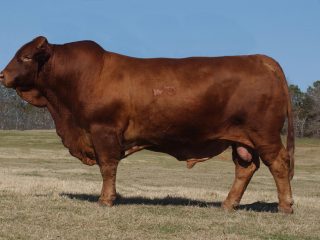Content
You don't have to be a veterinarian to determine when a cow will calve. Every cattle owner should know the signs of impending birth. It’s hard not to notice them, because the animal’s behavior changes a lot, and the cow’s appearance looks different.
What is calving in a cow?
For a cow, calving is not only the moment the calf is born, but also the last period of pregnancy. It lasts a certain number of days, usually about 14. During this time, the owner must prepare the conditions so that the birth takes place in a comfortable environment. In addition, during this period, you need to carefully monitor the cattle to understand that the cow will soon calve. If necessary, the animal will have to be helped.
What are the signs of a cow before calving?
Pregnancy in cows lasts about 285 days. However, calving may be delayed for various reasons, but not more than 15 days. In this case, you cannot do without a veterinarian, otherwise you may lose the animal and the calf. Usually a month before the approaching date of birth, the cow behaves still calmly.
What does a cow do before calving?
Changes in her behavior can be noticed a week before calving. The first heifer becomes irritable, hits herself with her tail, and gets nervous.When these signs appear, after a few days the cow loses her appetite. This indicates an approaching birth.
A day before calving, the heifer's udder fills with milk, which is a characteristic sign of imminent labor. It may leak from the nipples. Transparent mucous discharge is observed from the animal's genital tract - this is a normal variant.
When the cow has signs of imminent calving, you need to prepare warm boiled water, clean sterile towels, iodine, laundry soap and a manganese solution. All this will be useful when the calf emerges.
What does a cow look like before calving?
Among the external signs a week before calving, the following changes can be observed in the cow:
- the labia swell and become bright red;
- liquid mucous discharge of a transparent color appears;
- the udder swells and milk flows out;
- the pelvic bones diverge;
- the stomach drops noticeably.
The cow immediately before calving shows slightly different signs. The animal has difficulty standing on its feet, constantly lies on its side, and moans protractedly.
If the birth is very soon, the contractions become strong and unbearable. The uterus opens. The contents of the amniotic sac may leak from the genital tract if it bursts on its own.
How does a cow calve?
Before calving, it is necessary to prepare the cow and the premises. The bedding is replaced with fresh ones, and straw is placed under the head. The genital tract and anus are washed with clean water and soap.
If the cattle is not calving for the first time, then it will do everything on its own.However, there are times when a cow needs help. That is why it is necessary to determine in time that she will calve soon and to know how calving proceeds.
When contractions intensify, a gray amniotic sac appears from the vagina. If it does not burst on its own, then it must be torn apart by hand to free the calf's head.
Normally, the fetus moves with its front legs and its hooves point toward the ground. There may be a situation where he walks with his hind legs, but then the hooves should point up. In such positions, the calf will be able to get out on its own; it will not need outside help.
The newborn is placed on a clean cloth, after which the umbilical cord is cut off, 15 cm away from the body. All instruments must be sterile. The end is tied after smearing it with iodine. Immediately after this, the calf is brought to its mother so that she can lick the lubricant from it. If calving was difficult, she may refuse. In this case, the owner will have to wipe the calf himself with a damp, warm cloth.
What to do with a cow after calving
Immediately after calving, especially if it was the first, the cow is given the opportunity to lie down for about 30-40 minutes. During this time, the placenta should come out and the uterus should cleanse itself. Gradually the animal's strength returns. To make this happen faster, give a saline solution to drink.
After the placenta has passed, the bedding is completely changed. It's time for the first milking. First, the udder is washed with warm water and the nipples are massaged. All expressed colostrum is given to the calf. It can be difficult to milk a firstborn, but in the future this will have a good effect on her productivity.
Problems after calving
Most often, calving occurs independently and does not require human intervention. But in case of difficult childbirth, this cannot be avoided.In the following days, the cow needs to be well looked after, especially if there have been uterine ruptures or other problems. This will avoid complications in the postpartum period.
The most common problem after calving is thrush. Its signs can be noticed even before birth. A white creamy fluid is secreted from the genital tract; there is no mucous secretion. The animal must be treated immediately so that the calf does not become infected at the time of calving.
There are times when the afterbirth does not come out completely. Its parts remain in the uterus, which leads to its inflammation. From external signs you can observe:
- prolonged bleeding;
- stool disorder;
- remnants of placenta in the vagina.
The animal remains lying on its side and does not get up. It is difficult to determine the situation on your own; it is better to call a veterinarian who will conduct an examination.
In the first few days after calving, udder swelling may occur. Most often it occurs due to an incorrect diet - not enough straw. This condition can be determined by the swelling, dense structure and bluish color of the udder. The disease requires consultation with a veterinarian.
Tips and tricks
To reduce the risk of complications after calving, you need to properly care for the animal during pregnancy. At 7.5 months, the cow is transferred to a separate room and the diet is changed. 14 days before calving, the feed should be of especially high quality. All concentrated feeds are removed or their consumption is reduced to once a day. To prevent swelling in the cow, succulent feed is removed at the first signs of impending labor. In the last days of pregnancy, the diet is as follows:
- 60% cereals;
- 24% concentrated feed;
- 16% roughage.
The diet should also include hay, at least 10 kg per head. If it is not there, then you need to give vitamin complexes.
The nutrition of a pregnant cow plays a big role and is one of the reasons why the animal paces. Cattle should eat and drink at least three times a day. With the appearance of harbingers of imminent calving, fiber is introduced into the diet, but calcium intake is reduced. He delays the birth.
In addition, experienced cattle owners recommend walking a pregnant cow on a pasture, but no more than three hours. When the time comes, the animal will reduce its activity on its own. Cows that are kept in a stall constantly give birth to non-viable offspring.
Conclusion
You can determine when a cow will calve on your own, but the timing will be very arbitrary. More accurately, at a later stage of pregnancy, only a veterinarian can say this after a thorough examination of the uterus.










